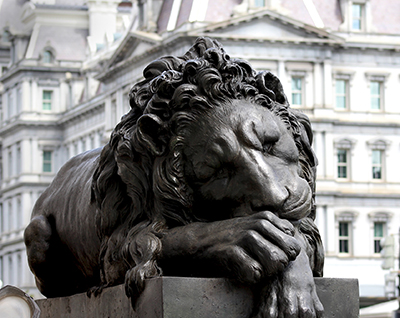Antonio Canova produced two sculptures of lions for his work on the Tomb of Pope Clement XIII. Several copies of them were made and distributed elsewhere, including a famous iteration which is now on display in the US.
The original designs were produced in marble after a long period of study and development. Canova would always work hard in the study phases in order to avoid having to make considerable changes later on in the process. The original marble works were then used for moulds which gave the opportunity to future copies, with bronze versions now being found on display outside of the entrance of the Corcoran Gallery of Art in Washington, D.C., USA (now the Corcoran School of the Arts and Design). They have been there since 1860, around seventy years after the original marble pieces were produced for the Tomb of Pope Clement XIII. Canova employed a large studio which was able to help him to fulfil a variety of different projects, some of which were for highly notable figures such as members of the religious order in Italy as well as the French Bonaparte family, who themselves need no introduction. One can draw a connection between these popular lion sculptures plus the work of British painter and sculptor, Edwin Henry Landseer, whose own lion sculptures now sit at the base of Nelson's Column in London, UK. Those have also become iconic parts of the city's sculptural offering, though many are entirely unaware of their origins.
The tomb of Pope Clement XIII can be found in St. Peter's Basilica, Vatican City, a location which has received contributions from some of the finest Italian sculptors in history. For example, Michelangelo would help out on a number of architectural and sculptural projects during his time here, although he remains most famous perhaps for his figurative sculpture David, which resides in Florence, as well as his frescoes for the Sistine Chapel ceiling. Institutions such as this would only be willing to work with the most respected artists in Italy at the time and even the most headstrong of creative minds would accept such opportunities with an entirely respectful and polite manner. The religious side of Italy during that period boasted wealth and power, which were not things that anyone would be foolish enough to go against. To have one's name connected to such institutions would also ensure many other projects from connected patrons, literally for the rest of their lives. Michelangelo himself would also work on a number of tomb designs of his own and it is advisable to compare how these two sculptors went about the same challenges, particularly considering that several centuries passed between their respective careers.
When examining the lions, you will notice that one of them is sleeping, whilst the other appears more vigilant. This combination is an attempt to tell us two things about the Pope, both his levels of moderation as well as his ability to work hard and with great determination. Many copies have been made since, some of which were handled by the artist himself whilst others followed on many years after his death, some even as late close to the end of the 19th century. Their relative connection to Canova will be the biggest impact on their ultimate valuation, but for many they are simply exquisite sculptures which are appreciated more for their aesthetic value rather than having any great connection to Canova himself. Animals of all types remain highly popular in the mainstream, though many other interpretations have been somewhat uninspiring and unimaginative. Amateur artists will regularly attempt such themes, but few will ever be able to compete with examples from the masters, such as these Canova Lions.




